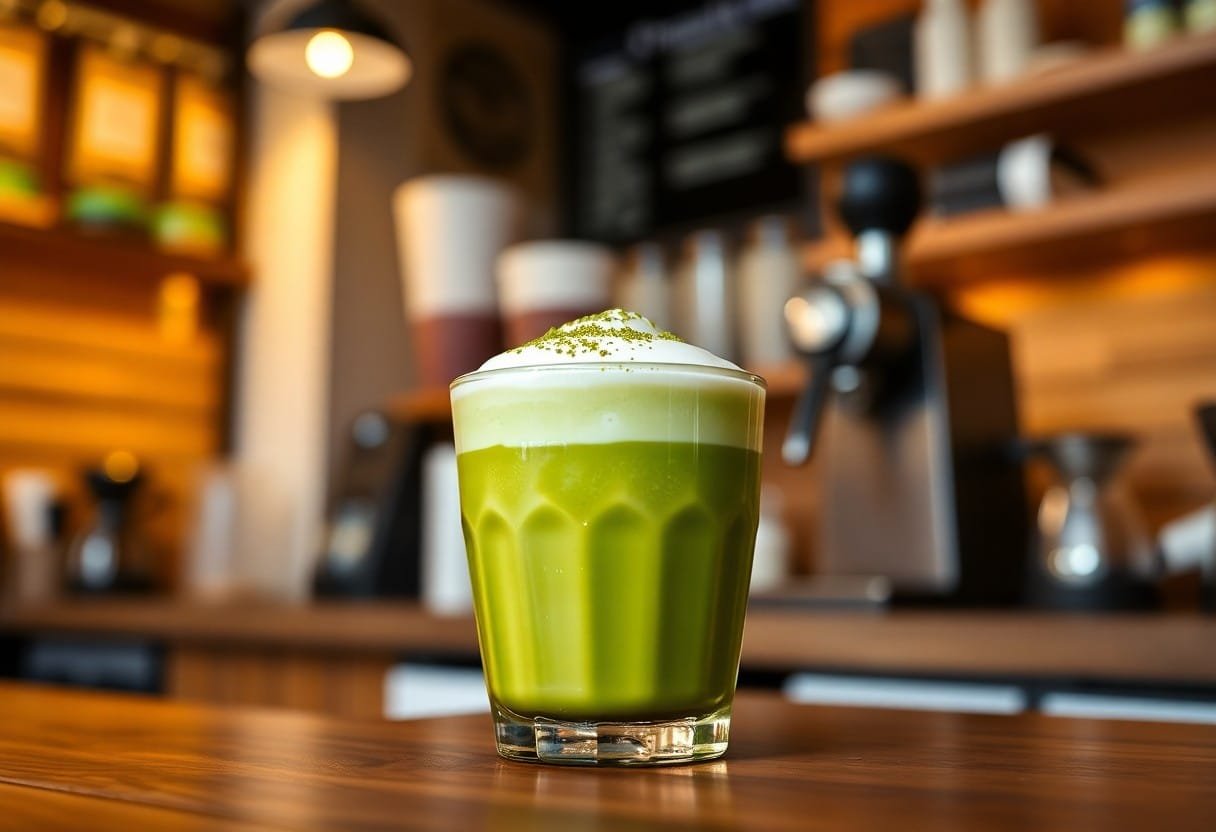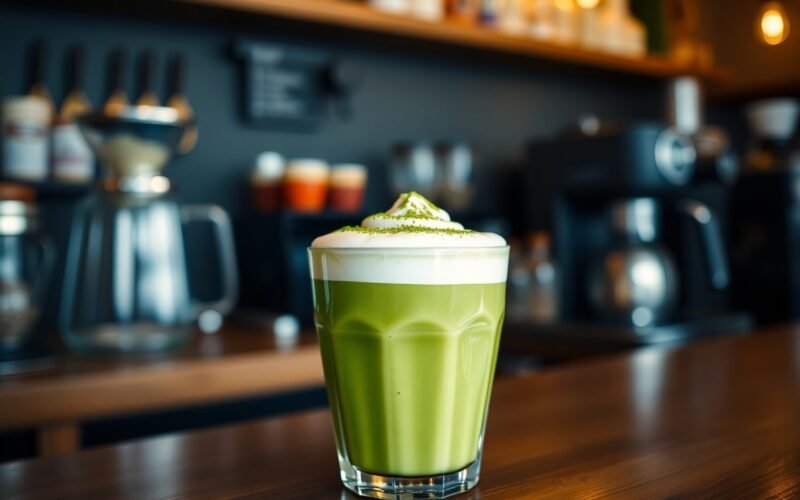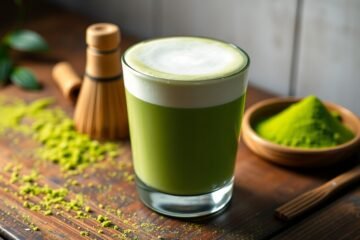Lattes have evolved, and now matcha lattes are becoming the go-to drink in coffee bars across the globe. You might be wondering what makes this vibrant green beverage so appealing compared to your regular coffee. With a rich history in Japan, matcha not only offers a unique flavor but also comes with numerous health benefits, including increased energy levels and enhanced focus. As more people seek healthier alternatives to traditional caffeinated drinks, you’ll see matcha lattes claiming their spot in your favorite coffee shop’s menu. Dive into this blog post to explore why matcha lattes deserve your attention.
Key Takeaways:
- Matcha lattes offer a unique flavor profile and are packed with antioxidants, making them a healthy alternative to traditional coffee drinks.
- The creamy texture and vibrant green color of matcha lattes appeal to health-conscious consumers and contribute to their increasing popularity on social media.
- Matcha lattes provide a more balanced energy boost with less anxiety compared to coffee, attracting those seeking a gentler caffeine experience.
The Uprising of Matcha: Culture Meets Trend
As matcha lattes gain popularity, a cultural renaissance is underway, blending traditional practices with modern aesthetics. You can witness this phenomenon in coffee bars around the world, where the vivid green hue of matcha attracts health-conscious consumers looking for alternatives to coffee. The intersection of Japanese heritage and contemporary wellness trends has brought matcha into the spotlight, transforming it into more than just a beverage; it has become a lifestyle choice that emphasizes mindfulness and nutrition.
Historical Roots of Matcha in Japanese Tea Ceremonies
Dating back to the 12th century, matcha’s roots are deeply embedded in Japanese culture, particularly in the Tea Ceremony, known as “Chanoyu.” This ceremonial preparation of matcha celebrates harmony, respect, purity, and tranquility, creating an immersive experience where you can connect with both your thoughts and the present moment. Early matcha was used by Zen Buddhist monks to enhance meditation, making it not just a drink, but a spiritual practice.
Its Evolution into a Global Beverage Phenomenon
Over the past two decades, matcha has transcended its traditional origins to become a global sensation in cafes and restaurants. Your local coffee shop might now offer matcha lattes alongside traditional espresso drinks, illustrating the adaptability and appeal of this vibrant green powder. With the rise of social media, matcha’s aesthetic allure and health benefits have captivated audiences worldwide, leading to a proliferation of matcha-infused desserts, smoothies, and even cocktails, making it a versatile ingredient that fits into various culinary traditions.
The explosion of the matcha phenomenon isn’t coincidental. Its popularity soared in the West thanks to health influencers and food bloggers who spotlighted its impressive antioxidant profile and vibrant color. A staggering 750% increase in Google searches for matcha over recent years indicates a massive shift in consumer demand. Coupled with the rise of specialty cafes focusing on unique beverage offerings, it’s no surprise that matcha lattes are now a staple in urban centers, catering to a diverse clientele eager for both taste and wellness.

Nutritional Superiority: The Health Debate
As you explore into the health benefits of matcha lattes versus traditional coffee, you’ll discover a compelling argument for making the switch. Matcha is not just a trendy beverage; it boasts impressive nutritional properties that may promote better overall health. Renowned for its high levels of antioxidants, vitamins, and minerals, matcha provides a refreshing alternative that can elevate your wellness journey. While both drinks have their merits, understanding how they stack up against each other can help you make informed choices about your daily caffeine fix.
Comparing Antioxidant Levels in Matcha and Coffee
| Component | Level per Serving (approx.) |
|---|---|
| Matcha | 1,200-1,400 ORAC* |
| Coffee | 200-400 ORAC* |
*ORAC stands for Oxygen Radical Absorbance Capacity, a measure of antioxidant capacity.
The Role of L-theanine: A Smoother Caffeine Experience
In matcha, you encounter L-theanine, an amino acid known for its calming effects that accompany the invigorating boost of caffeine. This unique combination provides a blended experience—enhancing focus while reducing the jitters that often accompany coffee consumption. With matcha lattes, you gain the energy associated with caffeine without the crash, making them an ideal choice for sustained productivity throughout your day.
Research shows that L-theanine increases alpha brain wave activity, promoting relaxation and mental clarity. Unlike the sharp spike in energy that coffee can induce, the gradual release of caffeine from matcha helps you stay alert longer, fostering a sense of calm focus. This makes matcha lattes a popular choice for those looking to enhance their cognitive performance while avoiding the drawbacks commonly associated with coffee addiction. By incorporating matcha lattes into your routine, you may find a healthier, more balanced way to enjoy your daily dose of caffeine.
Crafting the Perfect Blend: Techniques and Tips
Creating an exquisite matcha latte requires the right techniques and an attention to detail that can elevate your drink to café-quality. Focus on the temperature of your water, as high heat can scorch the delicate matcha, leading to a bitter flavor. Utilize a sift method with your matcha powder to avoid clumps, ensuring a creamy texture. Froth your milk to the right consistency for a velvety finish, and consider adding a splash of vanilla or sweeteners to enhance the overall taste. Knowing these tips will help you create a delightful experience that impresses every time.
Essential Ingredients for a Pleasing Matcha Latte
The foundation of a remarkable matcha latte lies in selecting high-quality ingredients. Authentic matcha powder sourced from Japan proves crucial, renowned for its vibrant green hue and rich flavor. Additionally, using freshly steamed milk—whether dairy or plant-based—plays a vital role in achieving that smooth mouthfeel. Emphasizing the importance of sweeteners, you might choose honey, agave, or simple syrup to suit your taste, while considering flavor additions like cinnamon or vanilla extract for a personal touch.
Step-by-Step Guide to Achieving an Authentic Flavor
Crafting an authentic matcha latte involves a simple yet effective process. Start with the right measurements—typically, 1 to 2 teaspoons of matcha powder for every cup of milk. Utilize a small bowl, pour in your matcha powder, and add 2 ounces of hot water (not boiling). Whisk vigorously in a zigzag pattern until you achieve a frothy consistency. Once blended, heat your milk until steaming, then pour it over the matcha mixture, stirring gently. Finally, adjust your sweetness to your liking before enjoying your delicious creation.
Step-by-Step Guide to Achieving an Authentic Flavor
| Step | Description |
|---|---|
| 1. Measure | Use 1-2 teaspoons of matcha for each cup of milk. |
| 2. Whisk | Add hot water and whisk until frothy. |
| 3. Heat | Steam or heat your milk until hot. |
| 4. Combine | Pour the steamed milk over the matcha you whisked. |
| 5. Sweeten | Add any desired sweeteners or flavors to enhance taste. |
Enjoying a matcha latte becomes an art when you follow these steps with care. Begin by selecting the finest matcha powder to ensure vibrancy and depth in flavor. Warm your water correctly; this retains all the health benefits without introducing unpleasant bitterness. Skillful whisking with a bamboo whisk or frother produces bubbles, critical for that signature creamy texture. Each stage builds upon the last, culminating in a matcha latte that impresses not just in taste but in appearance as well, creating a therapeutic experience that you’ll look forward to every day.
Aesthetic Appeal: Why Matcha Lattes are Instagram Gold
Matcha lattes have rapidly become the eye-catching darlings of social media, captivating your feed with their vibrant green hues and artistic presentations. These drinks offer not only a delightful taste but also an exceptional visual experience, making them the perfect choice for your next The Rise of the Matcha Latte. The elegance of a well-crafted matcha latte is a blend of color, texture, and imagination, inviting users to share their aesthetic moments with friends and followers.
The Visual Artistry of Matcha Foam and Presentation
Creating a matcha latte is akin to painting on a canvas; the vibrant green matcha foam serves as the base for your artistic flair. Baristas often experiment with various pouring techniques, creating mesmerizing latte art that captures both attention and admiration. The use of unique vessels and garnishes, like coconut flakes or edible flowers, further enhances the drink’s visual appeal, transforming an everyday beverage into a work of art.
The Psychological Impact of Colorful Food and Drink
Color plays a significant role in how food and drinks are perceived, and matcha lattes are no exception. The bright green color is often associated with health and vitality, creating a positive psychological impact on you as a consumer. Studies indicate that colorful foods evoke pleasure and joy, enhancing your overall experience and increasing the chances of sharing these moments online.
Research highlights that vibrant colors draw you in and ignite your appetite, making you feel more inclined to enjoy and capture that perfect shot for social media. The fresh green of matcha not only signifies its organic nature but also enhances feelings of freshness and renewal. In a world where visuals dominate the digital landscape, a matcha latte’s enchanting green hue serves as both an enticing beverage and a compelling photograph waiting to happen, encouraging you to share your delicious moments with others.
The Matcha Market Boom: Business Insights
The matcha market has seen a staggering growth, with projections estimating it to reach over $4 billion by 2027. This explosive demand is attributed to health-focused consumers and their growing interest in premium ingredients. Coffee shops are increasingly incorporating matcha into their menus, seizing the opportunity to cater to a clientele eager for innovative and nutritious beverage choices. This shift not only responds to consumer preferences but also positions brands as modern and health-conscious players in the competitive café landscape.
Trends in Consumer Preferences: Diners Seek Alternatives
As awareness of health benefits rises, many diners now prioritize functional beverages over traditional coffee drinks. Matcha lattes, packed with antioxidants and various health-promoting properties, are appealing to those looking for healthier alternatives to the usual caffeine fix. The trend towards plant-based diets and natural ingredients further fuels this shift, pushing many coffee drinkers to embrace matcha as a delicious, guilt-free option.
Competitive Edge: Coffee Shops Innovating with Matcha
In a saturated market, coffee shops are finding their competitive edge by creatively integrating matcha into their offerings. This includes not just standard matcha lattes but also unique items like matcha-infused pastries and smoothie bowls. By diversifying their menu, cafés tap into the growing trend of health-conscious consumers who desire flavorful yet nutritious choices. Innovative baristas are exploring flavor pairings, such as matcha with coconut or lavender, to create signature drinks that stand out. With expert preparation methods being employed, shops can offer a distinctly high-quality matcha experience, further attracting a loyal customer base.
Final Thoughts on the Matcha Latte Revolution
The matcha latte revolution isn’t just a passing trend; it’s reshaping your coffee choices and bringing health benefits to the forefront of beverage culture. With matcha’s rich antioxidant profile and ability to enhance focus, this vibrant green drink is drawing in a diverse audience. Coffee shops that embrace matcha are seeing increased customer loyalty, with sales growth of matcha-infused drinks often outpacing traditional coffee offerings. As you explore this dynamic beverage landscape, you’ll find that matcha lattes not only satisfy your taste buds but also align with your health-conscious lifestyle, proving they are here to stay.
FAQ
Q: What makes matcha lattes different from regular coffee?
A: Matcha lattes are distinct from traditional coffee due to their base ingredient, matcha, which is finely ground green tea leaves. Unlike coffee, which provides a quick caffeine boost, matcha contains a unique combination of caffeine and L-theanine, an amino acid that promotes relaxation without drowsiness. This leads to a more sustained energy boost and a calm alertness compared to the sometimes jittery effects of coffee. Additionally, matcha lattes can be prepared with various milk alternatives, allowing for a range of flavor profiles and dietary accommodations that coffee generally does not offer.
Q: Why are health benefits associated with matcha lattes more appealing than those of coffee?
A: Matcha lattes are becoming increasingly popular due to their numerous health benefits. Matcha is rich in antioxidants, particularly catechins, which are known for their potential in reducing inflammation and fighting free radicals. Many also find matcha beneficial for weight management, as it may enhance metabolism and fat oxidation. Unlike coffee, matcha doesn’t lead to a rapid spike and drop in energy levels, helping to avoid the afternoon slump that many coffee drinkers experience. The antioxidative properties and lower acid content make matcha a gentler option on the stomach for many consumers, promoting a healthier lifestyle.
Q: How can cafes adapt their menus to include matcha lattes effectively?
A: Cafes looking to incorporate matcha lattes can start by using high-quality matcha powder sourced from reputable suppliers, ensuring a superior flavor and color. Training baristas on how to properly prepare matcha lattes is necessary, as the preparation process involves whisking the matcha to achieve a smooth texture and inviting foam. Additionally, offering variations, such as iced matcha lattes, flavored syrups, or unique milk alternatives, allows customers to customize their experience. Creating seasonal matcha drinks, like pumpkin spice or holiday flavors, can also keep the menu fresh and entice both matcha enthusiasts and curious coffee drinkers alike.




